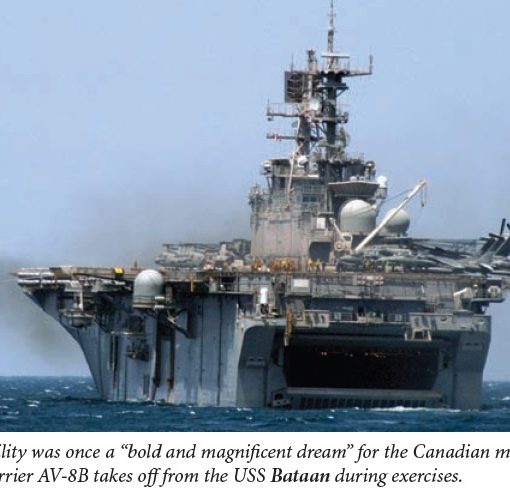The navy's plan to replace the existing fleet on a one-for-one basis plus a couple of extra ships over the next 30 or so years is ambitious and very expensive. A useful number hasn't been suggested yet, but I would think it has to be around $60 billion. To a politician, that is a truly frightening number, and represents a commitment with the potential to undermine the traditional processes of buying votes through local and popular spending.
Obviously, the whole navy plan isn't going to be approved in one fell swoop; it will be handled as such programs have always been on a piece-by-piece basis within the political comfort zone. That means the program, the pieces of which are carefully integrated for sound technological, industrial and practical reasons, is politically vulnerable. Worse, individual ship replacement programs could be separated from the larger fleet development concept as politicians or generals without naval visions fiddle with the plan. Is this fear-mongering? No, it is not; it has happened before in Canada - ask anyone who remembers the fiscal crises of the 1970s.
What people should begin to think about now are the implications of the present naval program falling apart. However, a couple of things can be assumed fairly:
- the 12 Halifax-class frigates will be modernized and sail for another 20 years with new helicopters; and
- some Joint Support Ships (JSS) will be built - it may only be two, but it could be three depending on how serious the Army is about acquiring a rapid reaction force.
It would be nice to assume that three of the four submarines will be modernized and that their strategic and operational value will become clear as the frigates begin their lengthy modernizations overhauls, but that capability has become a media lightning rod and the program has many influential opponents. It is very vulnerable and needs constant public support to survive - much more than it is getting now.
Likewise, one cannot make assumptions about the completion of the Arctic and Offshore Patrol Vessel (AOPV). This ship is still a long way into the future and that is a future that depends on considerable inter-departmental agreement over, to use Senator Colin Kenny's key question, "Who drives the bus?" Is it possible that we will see a ship operated by the Canadian Coast Guard with the military providing operational command and the RCMP and the military providing the tactical force? In theory it is not a bad idea, but for it to happen several bureaucratic rice bowls will have to be broken, and that might just be asking too much. The program will also need complete DND support.
Would the navy sacrifice some destroyers or frigates to advance the AOPV program in any form? Don't bet on it! Destroyers (and frigates of late) have always been the heart and soul of the Canadian navy and there is no reason to expect this to change, and for good reason. Only a destroyer/frigate-type ship can provide the necessary operational flexibility and endurance to give the government the types of response capability they continually call for.
Digressing for a minute to pick-up a couple of points about the rationale for warships. Think about the post-Afghanistan world, and yes Virginia there will be a post-Afghanistan world and the Canadian army better get used to that idea, and some things come into their true perspective. It will still be a troubled world and one that will demand military intervention and actions to impose and maintain stability. The following probable scenarios for military operations are self-explanatory:
- Post-environmental disaster relief and humanitarian assistance
- Evacuation operations in the wave of civil unrest or natural disaster
- Counter piracy and international crime patrols in areas like SE Asia and the Caribbean
- Stability operations in many places from the Caribbean to Africa to SE Asia and the Middle East
- Enforcing UN sanctions against Iran and/or North Korea or other non-conformist states
- Supporting UN/NATO/OAS military intervention operations
If Canada wants to remain a useful member of the world community it probably needs to be willing to play an active military role in global security, as it has for the last 60 or so years. To do that a balance of naval, air, and ground forces is necessary. The big question is, "What capabilities are needed?" and an important related question is, "Who must those forces be able to work with?" We may choose to do some things by ourselves, but we will choose to do most things collectively.
And that is where the political in-fighting begins because everyone has their own idea of the right force structure. The Canadian navy has presented its view of future force requirements, but will have to run a tough gauntlet to get to that structure. Which brings me back to my basic concern; what happens if the politicians and the generals don't buy the naval vision?
Could the navy remain effective with a force of 12 modernized frigates, 2-3 JSS, and a handful of coastal patrol vessels? This assumes that the navy loses the fight to keep the submarines and to replace the Tribal-class destroyers, which will be a function of the intensity of the in-fighting in DND over longer-term funding and whether the Afghan operation has to be funded out of naval and air force capital and operations budgets. It is not that I am against the Afghan operation, it is just that common sense says that it has to end eventually and that it is not in the country's best interests to keep funding that operation at the expense of long-term national security.
That size of naval force would present organizational problems similar to those of the late 1940s and early 1950 when the Royal Canadian Navy struggled to maintain operational commitments in Korea and to NATO in the Atlantic from a fleet that consisted of 11 destroyers, a carrier, and a few WWII frigates and minesweepers. There was no right mix of ships on each coast; the operational tempo was maintained with difficulty from both fleets and transit times became longer as East Coast ships went to Korea. It was an operational necessity, and it took 8 destroyers to keep 3 in Korean waters. The remaining ships provided NATO with a carrier for part of the time with one destroyer as an escort and occasionally a second - not exactly a very useful contribution to the Alliance. Fortunately, the Korean War was everyone's priority.
Back to tomorrow and the 12 frigate and 2 support ship navy. It would be possible, theoretically anyway, to deploy a 4 ship task group for six months with that size fleet; it will be possible to rotate some ships, but the cost is going to be that only a limited domestic capability will remain. The fleet's priority will go to sustaining the deployed task group. You can juggle the numbers any way you like, the result is that a 14 ship navy doesn't have a great deal of flexibility.
Does it have to be either AOPVs or Tribal-class replacements? One sincerely hopes not; for that would really add up to a huge drop in fleet capability and flexibility. Could one ship do both tasks? Obviously such a ship could be designed, but would that really be a practical solution? I doubt it. It is akin to the old joke about the Army committee formed to design a better horse - their answer was the camel.
Could the situation be improved by building a larger fleet of general-purpose, off-shore patrol vessels with an ice capability? That is also quite possible, but some would argue that the Canadian Coast Guard already has vessels that would fulfil that function. This begs the question, "Do we want to have the coast guard responsible for all off-shore patrols?" And the answer to that question lies in yet another question, "Could the coast guard actually undertake that role?" And that is a lot easier to answer. They could not do it now and it would take several years for them to develop the necessary tactical skills. This would require a complete re-structuring of the coast guard into a para-military, and thus non-unionized, force. That could be very difficult. So, really, we are back to Senator Kenny's question, "Who will drive the bus?" And we haven't answered that yet.
To bring this to a close, and to stop asking questions that people seem to have difficulty answering, some points about the navy's future fleet stand out:
- 12 frigates and a couple of support ships is the bare minimum to maintain a useful international naval presence and commitment to global security
- that force has to be backed-up with a dedicated coastal patrol capability that can function in the Arctic and northern waters
- those frigates will have to be replaced within 20 years and so the planning for the next generation of warship should be going on now.
Under that minimalist fleet structure, one has to ask if it makes sense to base the frigates and support ships on both coasts? Maybe the "blue water" fleet should be based on one coast. The thought of such a fleet re-structuring should give most admirals and politicians palpitations, but it is an option that needs to be considered in the interests of economy.
The grist of my argument comes round to one question, the navy has presented a comprehensive but politically vulnerable fleet plan, but have we really thought about the alternatives and about the implications of that plan not being approved?



